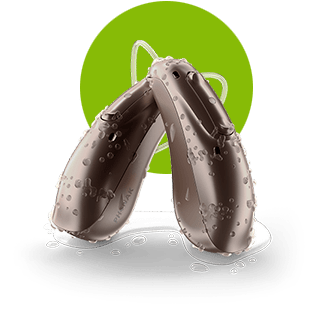
5 steps to fitting ActiveVent Receiver in Phonak Target
ActiveVent Receiver tackles the conundrum that audiologists face on a daily basis. Now your new clients who want to socialize after their tennis match don’t have to compromise first fit acceptance.
This looks like a pretty standard audiogram that you see daily isn’t it?
A mild to moderate hearing loss with good low frequency hearing sloping to a high frequency hearing loss.
Which acoustic coupling would you fit on this audiogram – an open dome, a vented dome, power dome or a vented custom earpiece?
Not so easy to answer just by looking at the audiogram. It would be good to know what the client’s hearing needs are – is streaming important?, are they often in challenging listening situations?, are they experienced users?, etc.
Example of why acoustic coupling is a challenge
Let’s imagine you have a client, named Peter. Peter attended his first appointment with his partner. He described an active lifestyle and he appeared tech savvy.
His audiologist fitted him with Audéo P90-R as they had the necessary hearing performance features to ensure that Peter would be able to maintain his social and physical well-being. As a first time hearing aid user, Peter was fitted with open domes to ensure a good first fit acceptance.
After 2 weeks, Peter excitedly reported how much he loves using his Audéo P-R to stream music when he goes running or to listen to podcasts. His partner reported that there was a significant improvement at home with the TV volume back to a healthy level. To top it off, Peter was not saying “what?” as often as before.
However, Peter, found that if the noise level increased significantly, he still needed to concentrate. As he is an active member of his local tennis club, he wishes to better hear the punchline of his tennis partners’ jokes and not look embarrassed if he misheard something.
Why changing the acoustic coupling might not help
The audiologist decided to swap him to an occluded SlimTip to help with speech understanding in noise. Immediately Peter noticed that his voice was echoey. She tried to adjust for this in Phonak Target, but even decreasing the low frequencies had no effect.
What now? Tell Peter that he has to get used to the sound of his voice or give him some communication tactics for the tennis club?
This is the conundrum that audiologists face on a daily basis – how to find the right balance between comfort and hearing performance.
To help solve this dilemma, we introduce ActiveVent Receiver, the world’s first intelligent hearing aid receiver. This receiver has been years in development and the concept came from an audiologist.
What makes ActiveVent Receiver intelligent?
- It is the first receiver with a mechanical vent that can be steered to open or closed based on the classified sound environment or signal.
- It eliminates the dilemma that faces Peter’s audiologist and thousands of audiologists around the word – no more compromise between open and closed fitting.
- The combination of Audéo P-R or Audéo P-RT and an ActiveVent Receiver means that clients can now have an open fitting when they want and a closed fitting when they need it.
The smart technology behind ActiveVent
- ActiveVentReceiver has a two-state vent. In one position it creates an open vent acoustics and in the other position it closes off the vent, creating closed acoustics.
- ActiveVent is driven by AutoSense OS 4.0, which automatically changes the vent from open to closed based on the detected environment of the wearer.
- By default, ActiveVent will be open in Calm Situation, Music, Speech in Car and in the blended programs of AutoSense OS 4.0. ActiveVent will be closed by default in Speech in Loud Noise and in the streaming programs.
- For manual programs that are created in Phonak Target 7.1.9 or later, ActiveVent can be set to either open or closed based on your client’s listening needs.
Why does ActiveVent work?
- When the vent is closed, there is no direct sound in noisy environments. This means when the vent is closed, direct sound such as background noise, is not able to enter.
- The hearing aid provides more low frequency energy which benefits microphone directionality, leading to speech intelligibility.
- When streaming, the closed vent contributes to a nice rich, bass sound, improving sound quality of streamed signals.
- When the vent is open, direct sound is able to enter and the hearing aid provides minimal low frequency energy amplification. This leads to natural sound quality, reduce occlusion, and aides in localization.
Peter would be a perfect candidate for ActiveVent. Below I’ve included 5 steps to follow when fitting ActiveVent.
Five steps to follow when fitting ActiveVent:Step 1: Acoustic Parameters Select MAV from the receiver menu. For earpiece options, select either Universal SlimTip AV or SlimTip Titanium AV. The Universal SlimTip can allow Peter to start trialing ActiveVent right away. You can proceed with taking earmold impressions to have SlimTip Titanium made and ready to be fitted for Peter’s follow-up appointment. Step 2: Feedback and real ear test Perform the feedback test. ActiveVent is open when the feedback test is performed. This allows you to verify if the fit of the SlimTip is appropriate for Peter. If the feedback threshold appears to limit the amount of gain available or reduce available headroom, reevaluate the insertion or fit of the SlimTip. Step 3: Global tuning ActiveVent receiver is only compatible with APD 2.0, APD Contrast 2.0, and NAL fitting formulas. It is not compatible with DSL fitting formulas. DSL by nature prescribes more gain compared to APD and NAL. With ActiveVent in a closed status, the additional gain may be considered too high with DSL. Step 4: Fine tuning Fine tuning is the perfect time to demo the effect of ActiveVent. Peter mentioned he participates in several social situations, such as monthly poker games. You create a manual Speech in Noise program as Peter may benefit with ActiveVent closed when he attends these games. You can simulate a Speech in Noise environment with speakers playing diffuse background noise (e.g. cafeteria noise, speech babble) to the side and rear of the client. This will give Peter an idea of what to expect when he is at his next poker game. Step 5: Device options Peter mentioned he enjoys streaming and that it has become an important feature for him. Enable the mute function. With a long press down on the multifunction button, the hearing aid microphones become muted, allowing Peter to enjoy listening to music with reduced environmental noise. To finish off the fitting, check the Tap Control sensitivity level and remind Peter that he can change it himself via the myPhonak app at any time. And finally, perform verification measures to ensure the hearing aids meet targets. That’s it. You have now completed an ActiveVent fitting. |
To learn even more about fitting this intelligent receiver in Target , I invite you to watch a ‘how to’ video on the Phonak Target Support page.
Co-author:


